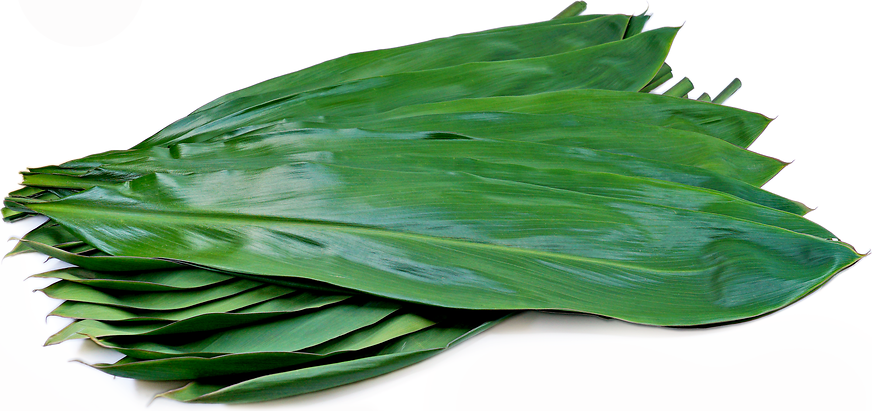


Green Ti Leaves
Estimated Inventory, bunch : 9.00
This item was last sold on : 07/26/25
Description/Taste
Ti leaves are large in size and are narrow, oblong, or lanceolate in shape, averaging 30-60 centimeters in length and 8-10 centimeters in width. The green leaves are smooth, shiny, and pliable and may change in shades depending on the season and climate. Ti leaves have a prominent central rib on the underside that extends the length of the leaf, and the leaves grow in spiral clusters on the branches. Ti leaves, when used as a wrap in cooked preparations, impart a subtle grassy flavor and aroma.
Seasons/Availability
Ti leaves are available year-round.
Current Facts
Ti leaves, botanically classified as Cordyline fruticosa, grow on an evergreen shrub that can reach up to four meters in height and are members of the Asparagaceae, or asparagus family. Also known as the Hawaiian Good Luck plant, Ki leaves, Palm Lily, Lauti, ‘Auti, and Cabbage palm, Ti leaves have traditionally been used in Hawaiian culture for their culinary attributes and as a natural material to make leis, hula skirts, and sandals. Ti Leaves can also be used as a garnish on serving platters or as individual plates for serving appetizers, salads, and entrees.
Nutritional Value
Ti leaves are not commonly consumed, but when boiled and used as a tea, they are believed to help reduce muscle tension and chest congestion.
Applications
Ti leaves are best suited for cooked applications such as boiling, grilling, and steaming. When mature, the leaves become chewy and fibrous and are not commonly consumed. They are predominately used as a wrap for grilling or steaming fish, taro, or pork and can also be used to form pockets or boats to make a mold for cooking custards and puddings. Ti leaves are used to make the traditional Hawaiian dish Lau Lau, which includes wrapping various meats in Ti leaves and steaming them in an underground oven or imu. Ti leaves can also be used instead of corn husks when making tamales or pasteles. They will keep up to five days when wrapped in a damp paper towel in the refrigerator and can also be frozen for extended use.
Ethnic/Cultural Info
Ti leaves were commonly used in the South Pacific for medicinal teas, food wrappings, and as a construction material. They were used to make thatch roofs, rain capes, clothing, ropes, sandals, fishing nets, serving plates, and cups. Ti leaves were also used medicinally by ancient Polynesians to treat a variety of ailments. The leaves could be boiled to make a tea that was said to aid in relaxation and relieve muscle tension, and the young leaves could be boiled and used to aid in respiratory congestion. Ti leaves were also commonly wrapped around hot stones and used as a compress for injuries and used as a bandage. Today, ti plants are still planted around houses in Hawaii as a way to bring good luck and are used at luaus for skirts, decorations, and food wrappings.
Geography/History
The ti plant is believed to be native to southeast Asia and the Pacific Islands. The plant was then introduced to the Hawaiian Islands and New Zealand via Polynesian settlers known as Kanaka Maoli. Today Ti leaves can be found at fresh markets and thrive in the warm tropical regions of southeast Asia, Australia, Hawaii, New Zealand, parts of Florida, and throughout the South Pacific.
Featured Restaurants
Restaurants currently purchasing this product as an ingredient for their menu.
| Hilton La Jolla Torrey Pines | La Jolla CA | 858-450-4581 |
| Alila Marea Beach Resort (Banquets) | Encinitas CA | 805-539-9719 |
| Golden Door | San Marcos CA | 760-761-4142 |
| San Diego Yacht Club | San Diego CA | 619-758-6334 |
| Omni Hotels | San Diego CA | 619-231-6664 |
| Cody's La Jolla | La Jolla CA | 858-459-0040 |
| InterContinental Vistal Kitchen | San Diego CA | 619-501-9400 |
| The Santaluz Club Inc - Banquet | San Diego CA | 858-759-3150 |
| Jake's Del Mar | Del Mar CA | 858-755-2002 |
| InterContinental Banquet Kitchen | San Diego CA | 619-501-9400 |
| Peohes | Coronado CA | 619-437-4474 |
| Donut Bar | San Diego CA | 310-488-5667 |
| insideOUT | San Diego CA | 619-888-8623 |
| Marriott Marquis North Tower | San Diego CA | 619-234-1500 |
Recipe Ideas
Recipes that include Green Ti Leaves. One
| My Hawaiian Home |
|
Tamale Time |
| Ucle Charlie Hawaiian Storyteller |
|
Uncle Charlie's "Bumbucha" Lau Lau |
| Mohala Kitchen |
|
Zongzi |
| The Tasty Island |
|
Kalua Pig Roasted in a Barbecue Grill |




